

3 Trends Shaping Mobile Development in 2016. 3 Trends Shaping Mobile Development in 2016 Last year saw the emergence of forces promising a tectonic shake-up of the mobile app development industry in 2016.

Following are three trends mobile developers should keep an eye on as we progress in the new year. New-Wave JavaScript Part of the larger story of JavaScript evolving into a first-class programming language option far beyond its Web site scripting origins, this trend was exemplified by the emergence of React Native in the mobile realm. Facebook engineers took their React framework for building Web sites and applied it to creating fully native mobile apps for iOS and Android.
What sets React Native apart from a zillion other JavaScript frameworks/libraries is its unique approach to cross-platform app development, eschewing the classic "write once, run anywhere" approach in favor of a "learn once, write anywhere" paradigm. Occhino highlighted various attempts to duplicate native widgets as an example. Enginursday: Open Source Cross-Platform Mobile App Development.
The New Age of Cross-Platform Mobile App Development. To build a mobile app, the first thing to decide used to be which platform to target first.

But now, with the right tools, apps can be developed once to run on every platform. Everyone has heard that promise before. Cross-platform mobile app development tools have been around for a while, but historically, they haven’t lived up to expectations. The vision promised that instead of hiring separate developers to build different apps for different platforms, one developer or team could write code that would become an app for multiple mobile platforms. But the reality was much messier. Mobile App Development made easy with Visual Studio and Xamarin.
Last month, we announced that Microsoft acquired Xamarin and welcomed the Xamarin team to Microsoft.
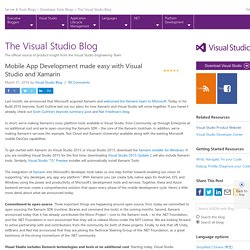
Today, in his Build 2016 keynote, Scott Guthrie laid out our plans for how Xamarin and Visual Studio will come together. If you haven’t already, check out Scott Guthrie’s keynote summary post and Nat Friedman’s blog. In short, we’re making Xamarin’s cross-platform tools available in Visual Studio, from Community up through Enterprise at no additional cost and we’re open-sourcing the Xamarin SDK – the core of the Xamarin toolchain. In addition, we’re making Xamarin’s services (for example, Test Cloud and Xamarin University) available along with the existing Microsoft mobile DevOps capabilities. To get started with Xamarin on Visual Studio 2015 or Visual Studio 2013, download the Xamarin installer for Windows. Xamarin launches major update to its cross-platform development tools.
Xamarin, the cross-platform development platform Microsoft recently acquired, is holding its annual developer conference today.
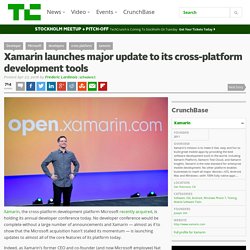
No developer conference would be complete without a large number of announcements and Xamarin — almost as if to show that the Microsoft acquisition hasn’t stalled its momentum — is launching updates to almost all of the core features of its platform today. Indeed, as Xamarin’s former CEO and co-founder (and now Microsoft employee) Nat Friedman told me, the service has seen its downloads increase massively since the acquisition — and it surely doesn’t hurt that Xamarin is now available for free in a Community edition. Friedman says downloads were up three and a half times in the last two weeks since the company announced its new pricing plan compared to the full month before the announcement. Some of Xamarin’s launches today were previously announced at Microsoft’s Build conference.
The Xamarin IDE (for Mac), though, will remain closed-source for now. Ten of the Best Cross-Platform Mobile Development Tools for Enterprises - App Development Marketplace. Over the last year or so the market for enterprise-ready mobile cross platform development has begun to take-off.
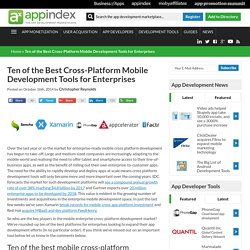
Large and medium sized companies are increasingly adapting to the mobile world and realising the need to offer tablet and smartphone access to their line-of-business apps, as well as the benefit of rolling out their own enterprise-to-customer apps. The need for the ability to rapidly develop and deploy apps at scale means cross platform development tools will only become more and more important over the coming years. IDC forecasts the market for such development platforms will see a compound annual growth rate of over 38% reaching $4.8 billion by 2017 and Gartner expects over 20 million enterprise apps to be developed by 2018.
This value is evident in the growing number of investments and acquisitions in the enterprise mobile development space. How to choose cross-platform app development tools. Companies are no longer running on single platforms such as Windows.

Today, your company supports phones, tablets and emerging technologies such as smartwatches and the promise of highly connected devices and sensors known as the Internet of Things. Many enterprises are now supporting many platforms with the leaders being Windows, Web, Apple's iOS and Google's Android. Xamarin vs Codename One Comparison. Posted in - Mobile App Date - 01 Jun. 2016 The smartphone market is fragmenting in massive proportions. iPhone had the first mover advantage in the smartphone race.
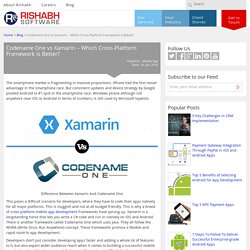
But consistent updates and device strategy by Google pivoted Android to #1 spot in the smartphone race. Windows phone although not anywhere near iOS or Android in terms of numbers, is still used by Microsoft loyalists. Difference Between Xamarin And Codename One This poses a difficult scenario for developers, where they have to code their apps natively for all major platforms. Developers don’t just consider developing apps faster and adding a whole lot of features to it, but also expect wider audience reach when it comes to building a successful mobile app.
Cross Platform: The Future of Mobile App Development. March 15, 2016 Cross Platform: The Future of Mobile App Development By Rahul Kaul in Miscellaneous Smartphones/Mobile Applications Web Development The surging demand for new and improved Smartphones and tablets is increasingly leading to ever pervasive demand for mobile apps.
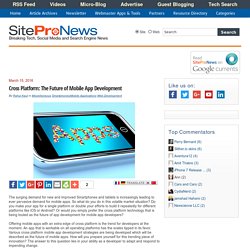
So what do you do in this volatile market situation? Do you make your app for a single platform or double your efforts to build it repeatedly for different platforms like iOS or Android? Offering mobile apps with an extra edge of cross platform is the trend for developers at the moment. Let us first understand what cross platform is. Cross platform works on a philosophy of write once, run everywhere Cross platform is executed with the help of writing an application with codebase and technology that facilitates its distribution and deployment across distinct devices and operating systems.